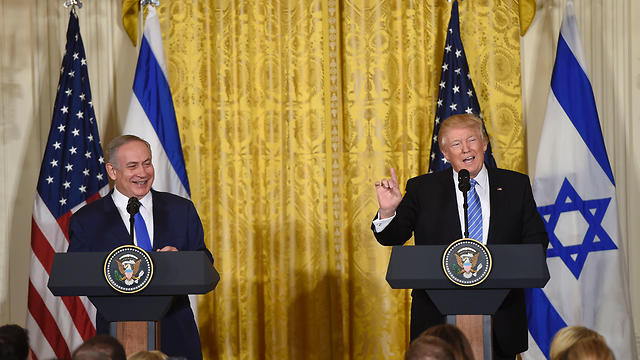
Trump helped Netanyahu pave road for one-state
Op-ed: The meeting with Trump loosened Netanyahu from the shackles of the two-state proposal. Netanyahu doesn’t have to freeze settlement building, or face threats and reprimands from Washington. Most importantly, he no longer has to fake interest in a peace process based on two states.
Just an hour before Prime Minister Benjamin Netanyahu boarded his plane from Tel Aviv to meet with US President Donald Trump for the first time, he stated, matter-of-factly: “We have to take into account the new president’s temperament.”
The White House didn’t appreciate Netanyahu’s comment, which could be interpreted to question Trump’s judgment, or worse, whether he's fit for the office. But Netanyahu’s comment actually reveals more about himself than it did about his relationship with Trump. Netanyahu was fearful of the vast unknown he was walking into. Trump’s pronouncements, especially when it came to Israel and the Middle East, are volatile and contradictory. Behind closed doors, would Trump give Netanyahu a carrot, or hit him with a big stick? Would he give the green light to settlement building, or plead—as he has before—“neutrality” with respect to the Israeli-Palestinian conflict?
The meetings with Obama, by contrast, were far more predictable: there was mutual disdain, clear expectations about what each leader would say, and the only aim was to maintain appearances of a warm relationship (mostly unsuccessfully). Netanyahu’s uncertainty about his meeting with Trump was heightened by National Security Advisor Michael Flynn’s abrupt departure. It was Flynn who was in charge of coordinating the meeting behind the scenes, and relaying information between the administrations.
During the meeting, Trump stunned the White House staff by departing from the decades-long US policy regarding the two-state solution. “I’m looking at two-state and one-state and I like the one that both parties like,” he said, as if he were trying to decide whether he wanted Doritos or pretzels. This turned to be a gift for Netanyahu. It’s understood by all that when the leader of the free world says "one-state or two, whatever you like," the real message is: no need for any action. Netanyahu can continue dragging his feet and maintaining the status quo, which has been his strategy from the start when it comes to the question of Palestinian statehood.
Netanyahu and Trump had something to bond over in their meeting: both leaders are at a low in terms of approval ratings. Netanyahu is under serious police investigation for corruption charges. Trump, on the other hand, had just suffered the pushback against his draconian executive orders, and is now dealing with a White House that looks more and more like a madhouse. It’s hard to say whether Trump has a grasp of what the two-state proposal even looks like, and whether he has bothered to read about it. It’s a world of a difference from Bill Clinton, who used to pore over maps and knew the layout of east Jerusalem like the back of his hand, or Obama, who could draw the proposed border between Israel and the would-be Palestinian state on a napkin.
Trump doesn’t seem to understand that the one-state, under Netanyahu, would be an apartheid state—of a different form from South Africa’s version, but apartheid nonetheless—where Israel would rule over millions of second-class citizens, who have no right to vote, and who have been living under brutal occupation for half a century.
It’s no coincidence that throughout decades of US foreign policy, there’s been bi-partisan agreement on the two-state solution. Two-states, for now, is the only game in town. When it comes to the relationship between Israel and Palestine, there are no magic formulas or wheels to be reinvented. But Netanyahu has no intention of accepting a full Palestinian state. He may settle for limited Palestinian control over some territories, but not full Palestinian sovereignty—and for this “pseudo”-state, Netanyahu would be right to say he’s got no partner on the Palestinian side.
The meeting with Trump loosened Netanyahu from the shackles of the two-state proposal. Netanyahu doesn’t have to freeze settlement building, or face threats and reprimands from Washington. Most importantly, he no longer has to fake interest in a peace process based on two states. Netanyahu left the White House elated.
When I asked him about the meeting with Trump at a press briefing at the Blair House, he spoke of Trump as if in love: “I met many presidents, and Trump is the friendliest toward Israel.” When asked about two-state versus one-state, Netanyahu made no commitments, except to say, “I don’t want to annex two million Palestinians (in West Bank) and I don’t want them to be our citizens.”
He may not want to, but that’s what he’s doing, and now fully backed by the White House.


















